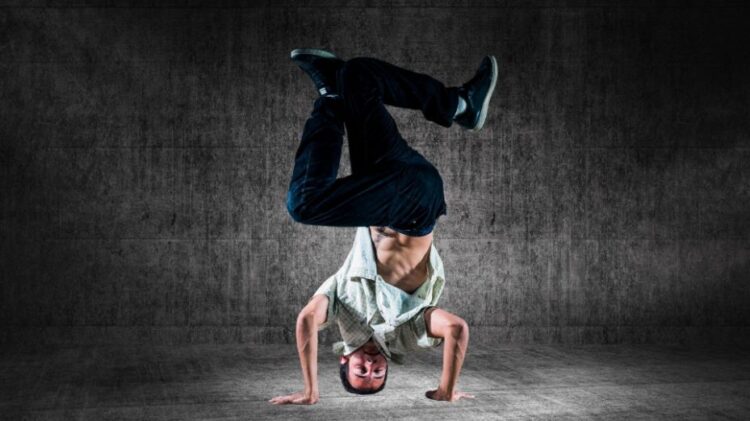(BREAKDANCING)

OBJECTIVE OF BREAKING: Win more sets than the opposing dancer.
NUMBER OF PLAYERS: 2+ players
MATERIALS: Comfortable clothing, protective gear (optional)
TYPE OF GAME: Sport
AUDIENCE: 6+
OVERVIEW OF BREAKING

Breaking, more commonly known as “breakdancing”, is a style of street dancing that involves extreme feats of athleticism and body control. While most people may remember breaking as a fad that took over the 90s, this style of dance has continued to evolve so much over the years that it is even set to make it’s Olympic debut as an official Olympic sport at the 2024 Paris Summer Olympic Games, along with other activities, such as sport climbing. This sport was added by the International Olympic Committee in very recent years, and the sport is influenced heavily by hip hop culture.
Elements of breaking were present in many different forms of dance as early as the late 1800s, although it wouldn’t be until the 1970s that breaking would officially become its own defined practice. During this time, breakdancers would almost always be featured alongside DJs at large parties, dancing to hip-hop music or rhythmic dance music.
Breaking found its true identity early on in the Bronx and other urban neighborhoods of New York City. It was here that breaking began to take a competitive identity, with large groups of people forming circles around dancers battling it out. These dance battles became known as “cyphers”, with this style of street competition later evolving to include rap battles.
Although breaking is most known for its roots in entertainment, the competitive dancer-versus-dancer nature of the sport has led to the creation of many annual breakdancing tournaments, such as the Red Bull BC One. After breaking was included in the 2018 Youth Olympic Games program, it was only a matter of time before it reached an even greater world stage.
SETUP
EQUIPMENT
Breakdancing is most commonly done in regular street clothes and sneakers. However, some dancers prefer to wear a helmet, knee pads, elbow pads, and wrist support when performing, especially if doing so on concrete streets.
COMPETITION FORMAT
Most breaking competitions are done in a bracket-style tournament, with two dancers facing off in a one-versus-one throwdown. In a throwdown, each dancer will take turns performing 60-second dance sets. In total, each dancer will complete two or three sets in each throwdown, with this number climbing closer to five in later tournament rounds.
Following in line with the battle aspect of breaking, both dancers in a throwdown compete to a continuous track provided by a DJ. The DJ chooses these tracks, meaning the dancers must improvise their routines to best suit the music. In other words, each dancer essentially jumps onto the dance floor in the middle of a track and performs a unique routine every time.
While the bracket-style tournament is the most common format, some competitions may use different formats, such as crew battles, in which teams of dancers compete against each other. Crews can be anywhere between two to ten dancers and sometimes more! In crew battles, just like in individual battles, each crew dances one at a time in the middle.
GAMEPLAY

SCORING
Breakers are scored by a panel of five judges based on the performance of their dance sets. Judges score each dancer on three main qualities that further include six total scoring criteria:
- Body (Physical) – Technique and Variety
- Soul (Interpretive) – Performance and Musicality
- Mind (Artistic) – Creativity and Personality
In each scoring category, the first element listed (technique, performance, and creativity) is worth 20% of a dancer’s final score. The second element listed (variety, musicality, and personality) is worth 13.333% of a dancer’s final score.
When scoring each category, judges use a unique Trivium scoring device. On this hand-held device, the two competitors are compared in each of the six scoring categories using a sliding scale. In other words, instead of each competitor getting their own score, each judge simply slides a bar in favor of either dancer in each scoring category to determine who did it better.
This means that each dancer essentially starts with 50% of the total score at the start of the battle (the scoring bars are directly in the middle). If a judge were to slide one dancer’s “technique” score bar so it took up ¾ of the bar, that dancer would now have gained half of the points possible in that scoring category. Since the technique scoring category is worth 20% of a dancer’s score, that means that this dancer would gain a 10% advantage on the scoreboard (meaning the score would be 60% to 40%).
The entire purpose of the Trivium scoring system is to allow judges to be able to compare dancers, not necessarily their individual performances. This is precisely why the degree to which a dancer wins a set isn’t relevant; a won set is a won set, and a lost set is a lost set.
With that said the Trivium scoring system is not the only method of scoring a breaking competition. In some cases, judges use a traditional 10-point scoring system or simply point at the breaker or crew they believe to have won.
The dancer who wins the majority of the sets wins the throwdown.
DANCE ELEMENTS
Break dancing routines consist of four primary styles of elements:
- Toprock: Strung-together footwork elements done from a standing position. These are often the first moves done in a set.
- Downrock: Elements performed on the floor with the dancer’s hands supporting their body as much as their feet.
- Power Moves: Acrobatic elements that require momentum in order to be performed. This includes moves such as the well-known head spin.
- Freezes: Poses in which a dancer will momentarily pause. These freezes are often done from extremely difficult positions, such as a dancer holding themself up with one hand while in an “armchair” pose.
Breakers will combine combinations of all of these styles into their dance sets.
Check out the final of Battle Pro 2019 where you can see some of the best breaking in action:
@RedBullBCOne All Stars vs. OBC Crew | Finals | Battle Pro 2019
END OF GAME
The dancer or crew who outperforms their opponent in the majority of sets wins the throwdown.
- 30 GAMES TO PLAY OVER TEXT - April 22, 2024
- 20+ FREE PRINTABLE BABY SHOWER GAMES - April 16, 2024
- 20+ College Party Games for the Best Night Ever! - April 2, 2024